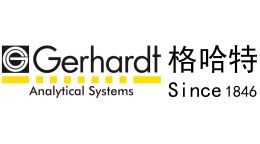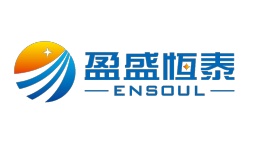方案详情文
智能文字提取功能测试中
姬松茸(太阳菇)的化学成分和抗氧化能力Chemical and Antioxidant Potential of Agaricus sylvaticus Mushroom Grown in Brazil姬松茸脂肪含量使用格哈特公司的SOXTHERM索克森全自动快速索氏提取仪以乙醚为溶剂进行测定The amount of lipids present in the sample of the A. sylvaticus mushroom was obtained through continuous extraction with a Soxhlet device, Brand Gerhardt, Soxtherm Model 2000, using sulfuric ether as solvent.提取出的油脂保存在10°C条件下,后续用于脂溶性维生素的色谱分析。The extracted oil was stored at 10°C for later chromatographic analysis of fat soluble vitamins.姬松茸(太阳菇)的化学成分和抗氧化能力Journal of Bioanalysis & BiomedicineCosta et al. J Bioanal Biomed 2011, 3:2DOI: 10.4172/1948-593X.1000042Researc ArticleOpen Access Open Access Citation: Costa JV, Garbi Novaes MRC, Asquieri ER (2011) Chemical and Antioxidant Potential of Agaricus sylvaticus Mushroom Grown in Brazil. J Bioanal Biomed 3: 049-054. doi:10.4172/1948-593X.1000042提取的油保存在10℃环境下,用于后续脂溶性维生素的色谱分析。 Chemical and Antioxidant Potential of Agaricus sylvaticus Mushroom Grown in Brazil Joice Vinhal Costa¹*, Maria Rita Carvalho Garbi Novaes2 and Eduardo Ramirez Asquieri3 1Professor, Instituto Federal Goiano- Campus Urutaí, Brazil 2Professor, School of Medicine, Escola Superior de Ciências da Saúde -ESCS-FEPECS; Universidade de Brasilia - UnB, Brazil3Professor, School of Pharmacy, Universidade Federal de Goiás - UFG, Brazil Abstract The chemical characterization of Agaricus sylvaticus (A. sylvaticus) cultivated in Brazil is necessary to determine nutritional and pharmacological substances in order to guarantee its safe use as food or herbal medicine. The objective of this study was to determine the chemical composition and assess the antioxidant potential of A. sylvaticus fungi grown in Brazil. Through this study it was able to observe the rich chemical composition of A. sylvaticus, highlighting the variety and amount of minerals as well as the high protein content of this fungus. It was also observed the great antioxidant potential of the aqueous, alcoholic and ethereal A. sylvaticus mushroom extracts, emphasizing the alcoholic extract, which testifies the extraordinary beneftis of this fungus in diet, since antioxidants prevent premature aging and various types of cancer as well. The composition of A. sylvaticus mushroom displayed differences when compared to the chemical composition of the same fungus in other studies and with other Agaricales fungi. Keywords: Chemical composition; Medicinal mushroom; Potential antioxidant Abbreviations: %: Percentage; Wavelengths; A. sylvaticus : Agaricus sylvaticus ; ABTS: 2,2-azinobis-3-ethylbenzothiazoline-6-sulfonic acid-diamonic;AOAC:AssociationofOf cfiailAnalyticalChemists; BHT: di-terc-butil metil fenol; DPPH: 2.2-difenilpicril-hydrazyl; HCl:Chloridricacid;HPLC:Highperformanceliquidchromatography; NH4+: Ammonium; PUFA: Polyunsaturated fatty acids; R²: Correlation coefcfieint; TBHQ: Terc butil hidroquinona Introduction Mushrooms are considered nutraceuticals or functional foods by many clinicians and researchers, a fact that has also stimulated the search by Brazilian producers for more advanced production techniques along with introduction of new species [1]. According to Urben [3], there is great genetic variety of native Agaricus genus mushrooms cultivated throughout the world. Strains producedbythesemushroomsresultfromthekindofsubstrate orcompostused,climaticconditions,cultivationareaandgenetic mutation that can occur naturally or artifciially. Mushrooms are highly nutritious foods, having high amounts of protein, equivalent to meat, eggs and milk, much higher than vegetables and fruits. Tehy contain vitamins such as thiamine, ribofalvin, ascorbic acid (Vitamin C), erbocalciferol (Vitamin D2), and a high percentage of minerals like calcium, iodine and phosphorus, besides considerable amounts of fiber [2]. Chemicalstudieshaverevealedthatthehighconcentrationof nutrients and active ingredients in mushrooms is directly related to the type of lineage used, which requires specifci conditions or several factors, such as: A) nutritional factors (substances essential for development:carbon, nitrogen, vitamins and minerals), B) abiotic factors (moisture content of compost and cover, temperature, light, oxygen, chemicals in air, CO2), C) and biotic factor (virus, bacteria, actinomycetes, fungi, nematodes,insects,mitesandgenetic),D)geneticfactors(natural or artifciial); E) processing factors (harvest, drying/dehydration and storage) [3]. Mushrooms have been used for therapeutic prevention of various diseases, in the form of drugs and/or functional foods [4]. In Brazil, despitethelowconsumptionofmushroomsbythepopulation, Agaricus genus fungi are becoming very popular due to attributed medicinal properties. Tehre are several studies that report the efefcts of A. sylvaticus (Sun mushroom) on various diseases and these properties may also be associated to the presence of bioactive compounds with medicinal value, such as phenolic compounds, polyketides, terpenes and steroids recognized as excellent antioxidants [5]. According to Elmastas et al. [6], phenolic compounds seem to be the main component responsible for the antioxidant activity in mushroom extracts. According to Tsai et al. [7], the antioxidant properties of Agaricusblazei maybeassociatedwithitshighconcentrationof tocopherols. Teh aim of this study was to evaluate the chemical composition ofdehydrated A.sylvaticus funguswithrespecttoprotein,lipids, carbohydrates, dietary fiber, minerals, liposoluble vitamins and vitamin C as well as determine the antioxidant potential of ether, alcoholic and aqueous extracts obtained from this mushroom. Materials and Methods Evaluation of chemical composition In this laboratory based experimental study, samples of dehydrated A.sylvaticus (Sunmushroom)mushroomwereobtainedfroma producerintheStateofMinasGerais.Mushroomswerecrushed inaWilleytypegrinder,ModelET-648,BrandTecnaltoallow greaterextractionofcomponents.Physicalandchemicalanalysis was performed at the Physical Chemistry Laboratory of “Centro de Pesquisa em Alimentos”, School of Veterinary Medicine (accredited *Corresponding author: Joice Vinhal Costa, Professor, Instituto Federal Goiano-Campus Urutaí, Brazil, Tel/Fax: 55 -(64)3465-1900; E-mail: joicevinhal@gmail.com Received January 21, 2011; Accepted March 09, 2011; Published March 14,2011 Citation:CostaJV,GarbiNovaesMRC,AsquieriER(2011)Chemicaland Antioxidant Potential of Agaricus sylvaticus Mushroom Grown in Brazil. J Bioanal Biomed 3: 049-054. doi:10.4172/1948-593X.1000042 Copyright: © 2011 Costa JV, et al. This is an open-access article distributed under the terms of the Creative Commons Attribution License, which permits unrestricted use, distribution, and reproduction in any medium, provided the original author and source are credited. by the Ministry of Agriculture, Livestock and Supply) and the Food Biochemistry Laboratory, School of Pharmacy, Universidade Federal de Goiás - UFG from March to June 2010. Moisture evaluation Moisture evaluation was performed in duplicate with dehydrated A. sylvaticus fungus, applying the ofcfiail method for moisture rating, using a kiln at 105ºC ± 3°C for 24 hours, established by the Ministry of Agriculture, Livestock and Supply, determined by the Association of Ofcfiail Analytical Chemists [8]. Tish methodology quantifeis the water withdrawn from the product by heating process, whereas the moisture content is calculated by the weight difefrence of the sample at the beginning (100%) and at the end of the process (100% -% water evaporated at 105ºC). Tish difefrence refelcts the moisture of the sample under analysis. First the sample was weighed (approximately 5g) and placed in a kiln at 105ºC until its weight remained constant. Afetr two weightings at intervals of five hours each, weight was observed to be constant. Next the sample remained in a desiccator in order to lower the temperature (up to room temperature) and was then weighed to check moisture content. Ash evaluation Ash evaluation of dehydrated A. sylvaticus fungus was performed by calcining the sample in furnace FDG Brand, Model 3P-S 7000, at 550°C for 12 hours, according to the ofcfiail method of AOAC [8]. Trhough this technique it is possible to determine the total ash produced using the heat in a mufef flurnace, where there is total destruction of organic matter present in the sample, leaving only those minerals present. Asampleofapproximately2gof A.sylvaticus mushroomwas weighed in a porcelain crucible, which had previously been incinerated withtheaidofBunsenburner,cooledandweighed.Tehntheset(sample + crucible) was incinerated in a mufef flurnace, frist at lower temperature and then at 550°C. Afetr incineration, the set was removed from the falsk, placed in a desiccator to cool of fand weighed when it reached room temperature. Teh amount of ash in the sample was detected from the weight difefrence between the weight of the set and the weight of the empty crucible. Te hmushroom ash sample served as a starting point for analyzing specifci minerals. Evaluation of minerals To determine the minerals, an atomic absorption spectrometry was used in spectrometer GBC Brand, Model 932AA. Duplicate analyses were performed. Te hprinciple of this technique is based on measuring the absorption of electromagnetic radiation intensity, from a primary source of radiation by gaseous atoms in ground state. It was possible to search for iron, zinc, manganese, sodium, potassium, cobalt, copper, calcium and magnesium, as these tests were performed in a laboratory where there were specifci cathode lamps for each of these minerals. Protein evaluation ForproteingradingtheKjedahlmethodwasusedfollowing the AOAC [8] methodology. Total nitrogen was obtained from the samplewhich,throughcalculationwastransformedintoprotein Nitrogen considering that each 100g of protein contains an average 16g of nitrogen. Tehrefore we used a 6.25 correction factor, which was multiplied by the total Nitrogen percentage of the sample, which corresponded to the protein percentages [9]. To develop this methodology we used a Nitrogen distiller . Protein analysis involved three phases. In the frist phase the nitrogen in the sample was transformed intoammonium(NH 4+)throughaciddigestionoforganicmatter, starting from 0.1 g of Degreased Dry Matter. In the second phase, separation was obtained by means of distillation and in the third phase, dosage by titration with HCl 0.02 N. Evaluation of lipids Teh amount of lipids present in the sample of the A. sylvaticus mushroom was obtained through continuous extraction with a Soxhlet device, Brand Gerhardt, Soxtherm Model 2000, using sulfuric ether as solvent, which has a boiling point of approximately 35ºC. Afetr extraction, the solvent was evaporated using a Rotavapor and lipid fraction was determined gravimetrically. Afetr 24 hours, we obtained the average weight of lipid fraction. Teh extracted oil was stored at 10°C for later chromatographic analysis of fat soluble vitamins. Evaluation of total dietary fbier Teh methodology for the evaluation of total dietary fiber of A. sylvaticus funguswasproposedbyAOAC[10],whoseprincipleis based on the sequential enzymatic digestion of dehydrated mushroom sample, in duplicate, with thermostable alpha-amylase, protease and amyloglucosidase. Te hdigested sample was then treated with alcohol to precipitate the soluble fiber before flitering, and the residue was washed with alcohol and acetone, dried and weighed. Carbohydrate evaluation Teh evaluation of carbohydrates was calculated by the difefrence, using rates obtained by the analysis of moisture, fixed mineral residue, proteins and lipids, following methodology recommended by AOAC[11]. Evaluation of fat-soluble vitamins Fat-soluble vitamins were determined by high performance liquid chromatography (HPLC), and the performance of duplicate analysis. Tehprincipleofthistechniqueevaluatestheextractionofactive compounds of vitamins studied and their conversion in free form in chloroform solution for later evaluation. For this analysis, it was used as sample the oil obtained in lipid analysis through Soxhlet extraction. It was used liquid chromatography, Gilson brand, with a stationary phase column E-18, column 10 cm/4.6mm and particles of 5micras. For the mobile phase was used a methanol and isocratic working system with 100% of methanol and 1mL/min flow. Variable wavelengths (l ) were used for each vitamin studied, as shown in Table 3. Vitamin C cvaluation VitaminCevaluationwasperformedintriplicate,following the Tillmans Method starting from titration of a standard solution ofascorbicacidandoxalicacidsolutionwithDCFIsolution(2,6-dichlorophenol indophenol sodium), and the solutions used were preparedasdescribedbytheAdolfoLutzInstitute(1995)forthe Tillmans Method. To determine Vitamin C, it was obtained an aqueous, non fractioned extract of A. sylvaticus mushroom by diluting dried mushrooms ground in water, kept under agitation at room temperature for one hour. Evaluation of antioxidant potential Tehantioxidantpotentialof A. sylvaticus mushroomwas determinedfollowingthemethodologyusedbyBorguini[12].In order to avoid interference of light in the sample, the experiment was conducted using material covered with aluminum foil. It was obtained the ether, alcoholic and aqueous extracts from the mushroom. First it was obtained the ether extract by diluting 2.5g of ground mushroom in 50mL of ethyl ether. From non-flitered residue and therefore ether-insoluble , it was obtained the alcoholic extract by adding ethanol at 1:20ratio (residue weight: volume of alcohol). And finally, it was obtained the aqueous extract by adding water to the non-flitered residue from the previous step and also adding distilled water at 1:20 ratio (residue weight: water volume). BHT was used as a standard antioxidant and DPPH as an oxidant. Tehantioxidantactivityofmushroomextractswasdeterminedby DPPH (2.2-difenilpicril-hydrazyl) described by BRAND-WILLIAMS et al. [13]. DPPH is a stable free radical which accepts an electron or hydrogen radical to become a stable diamagnetic molecule, and thus, is reduced in the presence of an antioxidant. Absorbance decrease was monitored at 517nm in a spectrophotometer Model SP-220, Biospectro brand, at intervals of 0,1, 2, 3, 4, 5, 10, 15 and 20 minutes of reaction. Teh values observed in the spectrophotometer were converted to a percentage scale, which indicates0%-noinhibitionoffreeradicalproduction,and100%indicates complete inhibition of the same. Quantifciation of total polyphenols Concentration of total polyphenols was determined by colorimetric methoddescribedbySingletonandRossi[14],usingtheFolin Ciocalteau reagent. For quantifciation of total polyphenols in the sample, a standard curve of gallic acid solution at concentrations of 0.01mg/mL to 0.06mg/mL was used. Te hcorrelation coefcfieint (R²) was calculated, resulting in R ² = 0.99775 to a 5% level of signifciance. Tish test was performed in triplicate, by using the ether, alcoholic and aqueous extracts of sample at the same concentrations utilized for the standard solution of gallic acid. Te hreading was performed with spectrophotometer Model SP-220, brand Biospectro at 750nm. Results Chemical composition Table1showstheresultsfoundbyanalyzingthechemical composition of A. sylvaticus dehydrated mushroom. One can observe the high protein content (41.16%), followed by carbohydrates (36.21%). Table 2 shows values found for rating minerals in dehydrated A. sylvaticus fungus, including iron, zinc, calcium, cobalt, magnesium, sodium,potassium,manganeseandcopper.Itwasnotpossibleto determine the dosage of other minerals performed in the laboratory owing to operational reasons. Te hquantities of liposoluble vitamins and vitamin C found in the mushroom A. sylvaticus are shown in Table 3. Liquid chromatography analysis enabled the analysis of vitamin A in acetate form, palmitate and propionate in addition to its pure form; of vitamin E in acetate form, alpha, beta, delta and gamma tocopherol; of vitamin K in the K1, K2, K3 and K4 form; however, vitamin D2 was detected by titration. Antioxidant potential Te hantioxidant potential of ether, alcoholic and aqueous extracts obtained from A. sylvaticus mushroom is shown in Table 4. Constituent Composition (% in 100g) Humidity 6.31 Ash 7.38 Protein 41.16 Lipids 6,60 Carbohydrates 36.21 Dietary fiber 2.34 * The chemical analysis was performed in duplicate. * The methods of chemical analysis of dehydrated A. sylvaticus mushroom are described by AOAC: Moisture (kiln at 105ºC), ash (muffle furnace at 550°C), proteins (Kjedahl), lipids (Soxhlet), Carbohydrate (difference from the other constituents of 100%), and dietary fiber (by enzymatic digestion of the sample). Table 1: Chemical composition of dehydrated A. sylvaticus . Constituent Composition Iron 726.90 mg/100g Calcium 1.35 mg/100g Zinc 549.25 mg/100g Cobalt 7.75 mg/100g Magnesium 21.19 mg/100g Sodium 255.34 mg/100g Potassium 613.03 mg/100g Manganese 23.18 mg/100g Copper 276.66 mg/100g *Analyses of minerals was performed by atomic absorption spectrometry. Table 2: Evaluation of minerals in dehydrated A. sylvaticus . Vitamin Composition Wavelength (ʎ) Ascorbic acid (Vitamin C) 12.65 mg/100g - Retinol acetate (Vitamin A) 0.000 mg/100g 460nm Retinol (Vitamin A) 0.001 mg/100g 460nm Retinol palmitate (Vitamin A) 0.000 mg/100g 460nm Propionate, retinol (Vitamin A) 0.000 mg/100g 460nm Vitamin D2 0.018 mg/100g 460nm Tocopherol acetate (Vitamin E) 0.000 mg/100g 295nm Alpha tocopherol (Vitamin E) 0.020 mg/100g 295nm Beta Tocopherol (Vitamin E) 0.000 mg/100g 295nm Delta Tocopherol (Vitamin E) 0.000 mg/100g 295nm Gamma tocopherol (Vitamin E) 0.000 mg/100g 295nm Phylloquinone (vitamin K1) 0.000 mg/100g 350nm Menaquinone (vitamin K2) 0.001 mg/100g 280nm Menadione (Vitamin K3) 0.000 mg/100g 460nm Naftaquinone (Vitamin K4) 0.000 mg/100g 350nm * The analysis of liposoluble vitamins was performed in duplicate, using liquid chromatography of the oil obtained from the lipids’ analysis of A. sylvaticus fungus . * The analysis for detecting vitamin C was performed in triplicate by titration from the non fractioned aqueous extract of A. sylvaticus mushroom . Table 3: Composition of vitamins of A. sylvaticus mushroom. Total polyphenols Teh amount of polyphenols detected in the ether, alcoholic and aqueous extracts are shown in Table 5. Discussion In this study we observed that the protein content of A.sylvaticus (41.16%) is superior when compared to the protein content of beef (approximately14.8%),aswellasofothermushroomsfromthe Agaricales family [15]. In addition to the high-protein content, protein from mushroom A. sylvaticus has high biological value, since it exhibits all the essential amino acids [16], as shown by research conducted by the Japan Food Research Laboratories [14] on A. sylvaticus grown in Brazil. Tehfollowinglevelsweredetectedatthetime:1.71g/100gof arginine,1.55g/100goflysine,0.62g/100gofhistidine,1.11g/100g ofphenylalanine,0.83g/100goftyrosine,1.72g/100gofleucine,1.01g/100gofisoleucine,0.39g/100gofmethionine,1.28g/100gof valine, 1.75g/100g of alanine, 1.25g/100g of glycine, 1, 26g/100g of proline, 5.73g/100g of glutamic acid, 1.20g/100g of serine, 1.21g/100g of threonine, 2.35g/100g of aspartic acid, 0.43g/100g of tryptophan and0,36g/100g of cystine. Becausetheyarehigh-proteinfood,mushroomsarehighly recommended for those who need a high protein diet, or for those whose diet has restrictions on lipids. Tish fact is of great importance regarding publichealth,sinceresearchrevealsthattheBrazilianpopulation includes a large number of overweight or obese individuals. Tish is certainlyalreadycausingpublichealthconcern,uponconsidering a population whose consumption proflie has considerably changed, especially during the 80’s, due to economic factors and the related social consequences [18]. According to results on the amounts of protein and lipids in the present study, A. sylvaticus mushroom can also be suggested as an important alternative health food. Inthe2005surveyconductedbytheJapanFoodResearch Laboratories on the A Sylvaticus grown in Brazil, values found for dehydrated mushroom were 4.4 g/100g of moisture, 39.4 g/100g of protein, 3.0g/100g of lipid, 45.6g/100g of carbohydrate and 7.6/100g of minerals. Comparing the above results with the present study, A. sylvaticus mushroom grown in Brazil in 2010 in dried state, shows higher values of moisture content (6.31%), lipids (6.60%) and protein(41.16%), which can be explained if taking into account difefrences in farming technique, region, climate, genetic mutations [3], conditions which are probably better in the areas where the mushroom is currently cultivated. In a study by Copercon, cited by Eira [19], the chemical composition of other mushrooms of the genus Agaricus , A. brasiliensis in dried state, showedthefollowingresults:water(7.5%),protein(36.6%),lipids(3.4%), fbier (6.8%), ash (7.3%), and carbohydrates (38.3%). Comparing these results with those of the present work, we see that only the ash content of the fungi studied was similar. Te hpresent study revealed 2.34% value of dietary fiber. According to Novaes and Novaes [15], the dietary fibers contained in mushrooms Extract Antioxidant potential (%) Alcoholic 75.6 Ethereal 14.6 Aqueous 14.6 antioxidant was *The potentialof A.sylvaticus mushroom observedfrom spectrophotometric analysis of three extracts from the sample. As oxidant we used the DPPH as standard. Table 4: Antioxidant potential of ether, alcoholic and aqueous of A. sylvaticus fungus extracts. Extract Ethereal 4.11 Extract Total polyphenols (%) Ethereal 4.11 Alcoholic 9.43 Aqueous 0.98 *TotalpolyphenolsresearchwasperformedusingtheFolin-Ciocalteouin spectrophotometer at 750nm. Table 5: Quantification of total polyphenol of ether, alcoholic and aqueous extracts of A. sylvaticus fungus. canabsorbtoxic,harmfulandcarcinogenicsubstances.Countless studies show fibers being associated to lower incidence of colorectal cancer, since it accelerates faecal excretion by laxative action, reducing the time spent in the intestines. With respect to the lipid content, we detected 6.60% of this nutrient in the A. sylvaticus fungus . According to Borchers et al. [20], although mushroomscontainsmallquantitiesoftotalfat,theyhaveahigh percentage of polyunsaturated fatty acids (PUFA) and low content of saturated fatty acids and cholesterol. According to Novaes and Novaes[15], crude fat mushrooms consists of several classes of lipids, including free fatty acids, mono- di- and triglycerides, sterols, terpenoids and phospholipids, especially lecithin. Teh Japan Food Research Laboratories also performed analysis of sodium (4.2mg/100g), iron (21.2mg/100g), calcium (35.7mg/100 g), potassium(3.15mg/100g)magnesium(100mg/100g),copper(8.24mg/100 g), zinc (6.61mg/100g), manganese (0.65mg/100 g), selenium (361 g/100g), and cobalt (0.13ppm). Neither molybdenum nor boron was detected. Comparing these results with this study, we can observe thediscrepancybetweenresultsforthemostresearchedminerals, whichcomeinhigherconcentrationsinthiswork.Accordingto Urben [3], this variation in minerals can also be explained by the type of crop, climate, region, and genetic mutations, among others, found more favorable in techniques used at present to cultivate the genus A. sylvaticus mushroom . According to [16], mushrooms have signifciant amounts of sodium. Teh presence of potassium, calcium, phosphorus, magnesium, iron and zinc was also observed by Borchers et al. [20]. In a study by Copercon, cited by Eira [19], the mineral composition ofthedehydratedmushroom A.brasiliensis showedthefollowing results for phosphorus, iron and calcium: 939mg/100g, 18.2mg/100g and 41.6mg/100g, respectively. Olivera et al. [18], studying the fungus A. blazei, found high levels of minerals such as potassium (2.34%), phosphorus (0.87%), calcium (0.07%), magnesium (0.08%), sulfur (0.29% ), copper (61.88 mcg), zinc(86.90 mcg), iron (79.63 mcg). Among the vitamins exhibited by A. sylvaticus surveyed by the Japan Food Research Laboratories in 2005, the following substances were not detected in the sample: α-carotene, β-carotene and Vitamin C. However, values found were 1.21mg/100g of thiamine (Vitamin B1),3.41mg/100g of ribofalvin (Vitamin B2), 0.83mg/100g of Vitamin B6,0,17µg of Vitamin B12, 5,8µg of calciferol (Vitamin D), 0.36mg/100g of folic acid, 39.4mg/100g of pantothenic acid, inositol 201mg/100g and39.9mg/100g of niacin. As seen in Table 3, vitamin C was detected in samples of A. sylvaticus analyzed in this study, which disagrees with the results presented by the Japan Food Research Laboratories [17]. According to Lederer [21], the importance of vitamin C is associated with several types of cancer, and daily doses administered to patients with cancer have improved their survival. Among the surveyed liposoluble vitamins, alpha tocopherol within the D complex, retinol, within the A complex and menaquinone from K Complex were detected. According to Soares [22], the accumulation of these compounds is dependent on the handling, processing and maturity of mushroom at harvest. Becausetheyareobtainedsynthetically,tocopherolacetateand retinol acetate were not detected in samples of dehydrated A. sylvaticus mushroom .AccordingtoBorchersetal.[20],mushroomscontain signifciant amounts of niacin, thiamin, ribofalvin, biotin, ascorbic acid and pro-vitamins A and D. According to Eira and Braga [23], knowledge of the chemical composition of mushrooms is very important, and in Brazil the genetic and physiological studies, basic and applied, can be expandedaimingatselectingmorestableandproductivelineages, establishing moreappropriatephysiological conditions forthe cultivation of mushrooms so as to attain the desired standard of quality. AccordingtoSilvaetal.(24),despitethehighbiodiversityof mushroomsfoundinBrazilandgreatexploitationpotential,there is little data on the antioxidant activity of mushroom extracts, since antioxidantshavetheabilitytoscavengefreeradicals,whichare harmful to human health [25]. Antioxidants are able to slow oxidation rate, inhibiting free radicals andpreventingtheonsetofdiseases,thuscontributingtogreater longevity, making the balance between free radicals and the antioxidant defense system essential [26]. Clinicalandexperimentalstudiesdemonstratethatdietary supplementationwith Agaricales mushroomsandothermedicinal fungi exert positive nutritional, medicinal and pharmacological efefcts and can be used as an adjuvant in cancer therapy. Te hmechanisms of action of bioactive compounds found in mushrooms are yet to be fully elucidated in the literature, but scientifci evidence suggests that these substances are able to modulate carcinogenesis not only at early stages, but at more advanced phases of disease progression as well, providing beneftis to individuals with various types of cancer, mainly by stimulating the immune system [27]. Regarding antioxidant activity it was observed that the alcoholic extract of the mushroom A. sylvaticus has great antioxidant potential (74.6%), suggesting that most antioxidant compounds present in this mushroom can be more easily diluted in alcohol. However, the aqueous and ether fractions showed lower antioxidant potential (14.6% each) when compared to alcoholic fraction. Teh aqueous fraction presented reduced antioxidant potential (14.6%) compared to results reported by Percario et al. [28] for the fungus in liquid suspension (50%), since in this work, antioxidant compounds had already been extracted by ether and by alcohol. Polyphenols make a heterogeneous group, composed of several classes of substances with antioxidant capacity, among which phenolic acids and falvonoids stand out. Teh antioxidant activity of polyphenols is mainly due to its reducing properties, whose intensity of antioxidant activityexhibitedbythesephytochemicalsisnotablydifefrentiated becauseitdependsfundamentallyonthenumberandpositionof hydroxyl groups present in the molecule [29]. Inthisstudywedeterminedtheamountoftotalpolyphenol for the etheric, alcoholic and aqueous extracts. We noticed that the largestamountofalcoholicextractisconcentratedinpolyphenols(9.43mg/100g) followed by etheric extract (4.11mg/100g), and aqueous extract (0.98mg/100g). Te huse of ethanol made possible the extraction of a higher content of polyphenols, since the alcoholic extract of the A. sylvaticus sample exhibited higher total phenolic content than the aqueous and ethereal which hold lower levels of these constituents. Aiming to evaluate the antioxidant capacity of the A. sylvaticus mushroom in difefrent forms of preparation (liquid suspension, fresh, dry and tablets), Percario et al. [28] assessed the ability of samples to inhibit in vitro the formation of free radicals by ABTS (2,2-azinobis-3-ethylbenzothiazoline-6-sulfonicacid-diamonic)overaperiodof90 seconds, resulting in decreased absorbance at 600nm.Te hauthors observed excellent antioxidant activity (%) in all forms of preparation of A. sylvaticus at concentrations of 1mg sample. Teh authors emphasized that the temperatures used in the preparation of the samples were 60°C for the dried mushroom and liquid suspension, since high temperatures can inactivate most molecules with antioxidant properties present in A. sylvaticus According to the authors, these molecules are easily degraded when exposed to industrial processes, which reduces their antioxidant capacity. According to Barros et al. [30], the cooking processes are responsible for the reduction of nutrients with antioxidant capabilities in several mushrooms analyzed in Portugal. Percario[28]researcheddifefrentmoleculeswithantioxidant capacityin A.sylvaticus fungus ,andfoundresultsof72mg/gfor β-Glucan in the liquid suspension and 14.1mg/g in tablet form. For falvonoids, values of 0.88mg/g were found in liquid suspension and 0.63mg/g in tablet form. For total phenols, values were 0.1mg/g for liquid suspension and 3.4mg/g for tablet form. Te hauthor suggested that the antioxidant activity of A. sylvaticus mushroom is due to the entirety of molecules it contains, and not a specifci component only. In a study performed by Silva et al. [24] the antioxidant potential of difefrent extracts of the mushroom A. blazei was evaluated by the DPPH method. Teh authors also observed a higher antioxidant activity(28.6%) in methanol extract: aqueous (1:1), with extraction time of six hours. Results displayed in the present work , confrimed that the best antioxidant activity for Agaricus sylvaticus extract was in the alcoholic fraction(74.6%),whichshowsthatcomponentswithantioxidant properties of this mushroom are more easily soluble in alcohol. Someauthorsutilizedtheresearchedmushroomextractsas ingredients in some foods in order to find out the antioxidant efefct in processed products. Silva et al. [24] added the methanol: water extract(1:1) to soybean oil and obtained good results. Results showed efefctive protection (20.4 h of oxidative stability), and the activity of A. blazei extract was more efcfieint than the synthetic antioxidant BHT (100mg/kg) and less efcfieint than the TBHQ (50mg/kg). Silvaetal.[24],evaluatingthe A.blazei mushroom ,obtained concentration of 15mg/g of total phenolic compounds in methanol extract: water extract (1:1). Teh content of total phenolic compounds present in A. blazei was also assessed by Tsai et al. [7], who obtained 5.67mg/gofphenoliccompoundsintheaqueousextractofthis mushroom. In this study, the values of total polyphenols were lower. Teh alcoholic extract of the mushroom A. sylvaticus showed 9.43mg/100g of phenolic compounds. Teh aqueous and ether extracts showed 4.11 and 0.98mg/100g respectively. Conclusion Trhoughthisstudywewereabletoobservetherichchemical compositionof A.sylvaticus,highlightingthevarietyandquantity of minerals and the high protein content of this mushroom. It was also found that the chemical composition of the mushroom showed difefrences when compared to the composition of the same mushroom in other studies and other mushrooms of the Agaricales genus. It was also observed the great antioxidant potential of aqueous, alcoholicandetherealextractsofthe A.sylvaticus mushroom , emphasizing the alcoholic extract, which demonstrated the extraordinarybeneftisofthismushroomindiet,consideringthat antioxidantspreventagainstprematureagingandvarioustypesof cancer. References 1. Furlani RPZ, Godoy HT (2005) Nutritional value of edible mushrooms. Revista do Instituto Adolfo Lutz 64: 149-154. 2.Valentão P, Andrade PB, Rangel J, Ribeiro B, Silva BM, et al. (2005). Effect of the conservation procedure on the contents of phenolic compounds and organic acids in chanterelle (Cantharellus cibarius) mushroom. J Agric Food Chem 53: 4925-4931. 3.Urben AF (2007) Morphological and physiological access of Agaricus blazei and A. sylvaticus. Biotechnology Science and Development 37. 4.Barros L, Baptista P, Correia DM, Morais JS, Ferreira IC (2007) Antioxidant activity of Portuguese wild edible mushrooms. Journal of Agricultural and Food Chemistry 55:4781-4788. 5.CheungLM,CheungPCK,OoiVEC(2003) Antioxidantactivityandtotal phenolics of edible mushroom extracts. Food Chemistry 81: 249-255. 6.Elmastas M, Isildak O, Turkekul I, Temur N (2007) Determination of antioxidant activity and antioxidant compounds in wild edible mushrooms. Journal of Food Composition and Analysis 20: 337-345. 7.Tsai S, Tsai H, Bad J (2007) Antioxidant properties of Agaricus blazei, Agrocybe cylindracea and Boletus edulis . Lebensmittel Wissenschaft und Technologie -Food Science and Technology 40: 1392-1402. 8.AOAC - Association of Official Analytical Chemists (1995) Official Methods of Analysis . 16th edition USA. 9.AOAC -Association of Official Analytical Chemists (1993) Peer Verified Methods Program, Manual of Policies and Procedures AOAC International:Arlington, VA. 10. AOAC - Association of Official Analytical Chemists (1997) Official Methods of Analysis of AOAC International. 16th edition Gaithersburg: USA. 11. AOAC - Association Official Analytical Chemists (2002) Official Methods of Analysis of the Association Chemist 20th edition Washington. 12. Borguini RG (2006) Antioxidant potential and physical-chemical characteristics of organic tomato (Lycopersicon esculentum) in comparison with conventional tomato. São Paulo: USP, Tese (Doutorado) – Programa de Pós-Graduação em Saúde Pública, Universidade de São Paulo, São Paulo. 13. Brand-williams W, Cuvelier ME, Berset C (1995) Use of a free radical method to evaluate antioxidant activity. Lebensmittel - Wissenschaft und-Technologie 28: 25-30. 14. Singleton VL, Rossi JA (1965) Colorimetry of total phenolics with phosphomolybdic-phosphotungstic acid reagents. American Journal of enology and Viticulture 20: 144-158. 15. Novaes MRCG, Novaes LCG (2005) Pharmaco-Nutrients in edible mushrooms and other basidiomycetous Agaricales. Journal of Clinical Nutrition 20: 181-187. 16. Mala A (2002) Importance of using mushrooms: nutritional and medicinal . Rio de Janeiro: Embrapa 143-161. 17. JAPAN. Japan Food Research Laboratories. http://read.jst.go.jp/index_e.html 18. OliveiraMW,OliveiraER,LimaLCO,villasboasEVB(1999)Proximate composition of mushroom (Agaricus blazei) III Simpóssio Latino Americano de Ciências dos Alimentos, November, 1999 - Campinas - SP. R. Universidade de Alfenas, Alfenas, 5: 169-1172. 19. Eira AF (2003) Cultivation of medicinal mushroom Agaricus blazei (Murrill) ss.Heinemann or Agaricus brasiliensis (Wasser et al.).Viçosa: Easy to Learn 398. 20. Borchers,AT,SternJS,HackmanRM,KeenCL,GershwinME(1999) Mushrooms, tumors, and immunity. Proc Soc Exp Biol Med 221: 281-293. 21. Lederer J (1990) Food and cancer 3rd edition, São Paulo: Malone Two. 22. Soares AA (2007) Atividade antioxidante e compostos fenólicos do cogumelo AgaricusblazeiMurrill .Maringá:UEM,2007.Dissertação(Mestrado)-Programa de Pós-Graduação em Ciências Biológicas, Universidade Estadual de Maringá-PR, Maringá. 23. Eira AF, Braga GC (1997) Manual do cultivo teórico e pratico do cultivo de cogumelos comestíveis, Fundação de Estudos e PesquisasAgrícolas Florestais . 34-36. 24. Silva AC, Oliveira MC, Del re PV, Jorge N (2009) Use of mushroom extracts as natural antioxidant in soybean oil. Science and Agrotechnology 33: 1103-1108. 25. Dorman HJ, Kosar M, Kahlo K, Holm Y, Hiltunen R (2003) Antioxidant properties and composition of aqueous extracts from Mentha species, Hybrids, Varieties, and Cultivars. Journal of Agricultural and Food Chemistry 51: 4563-4569. 26. Ferreira LA, Matsubara LS (1997) Free radicals: concepts, related diseases, defense system and oxidative stress. Revista Associação Médica Brazileira 43:61-68. 27. FortesRC,NovaisMR(2006)Efeitosdasuplementaçãodietéticacom cogumelos Agaricales e outros fungos medicinais na terapia contra o câncer. Revista Brasileira de Cancerologia 52: 363-371. 28. Percário S, NaufalAS, Gennari MS, Gennari JL(2009)Antioxidant activityofediblemushroomblushingwood,AgaricussylvaticusSchaeff.(Agaricomycetideae) in vitro. International Journal of Medicinal Mushrooms 11:133-140. 29. Kaur C, Kapoor HC (2002) Anti-oxidant activity and total phenolic content of some Asian vegetables. International Journal of Food Science and Technology 37: 153-161. 30. BarrosL,BaptistaP,CorreaMD,MitchellJS,FerreiraIC(2007)Effects ofconservationtreatmentandcookingonthechemicalcompositionand Antioxidant activity of Portuguese wild edible mushrooms. J Agric Food Chem55: 4781-4788.
关闭-
1/6
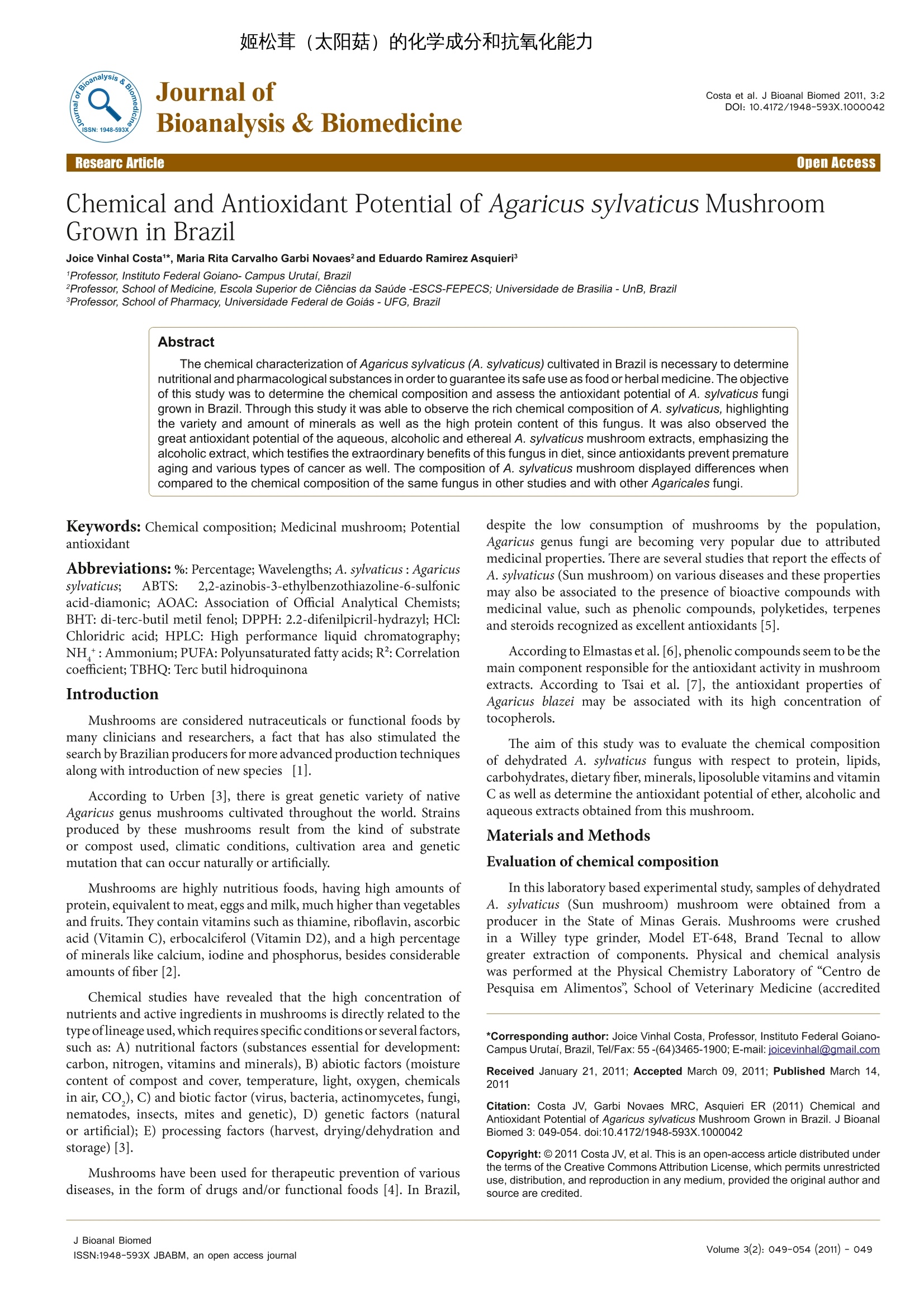
-
2/6
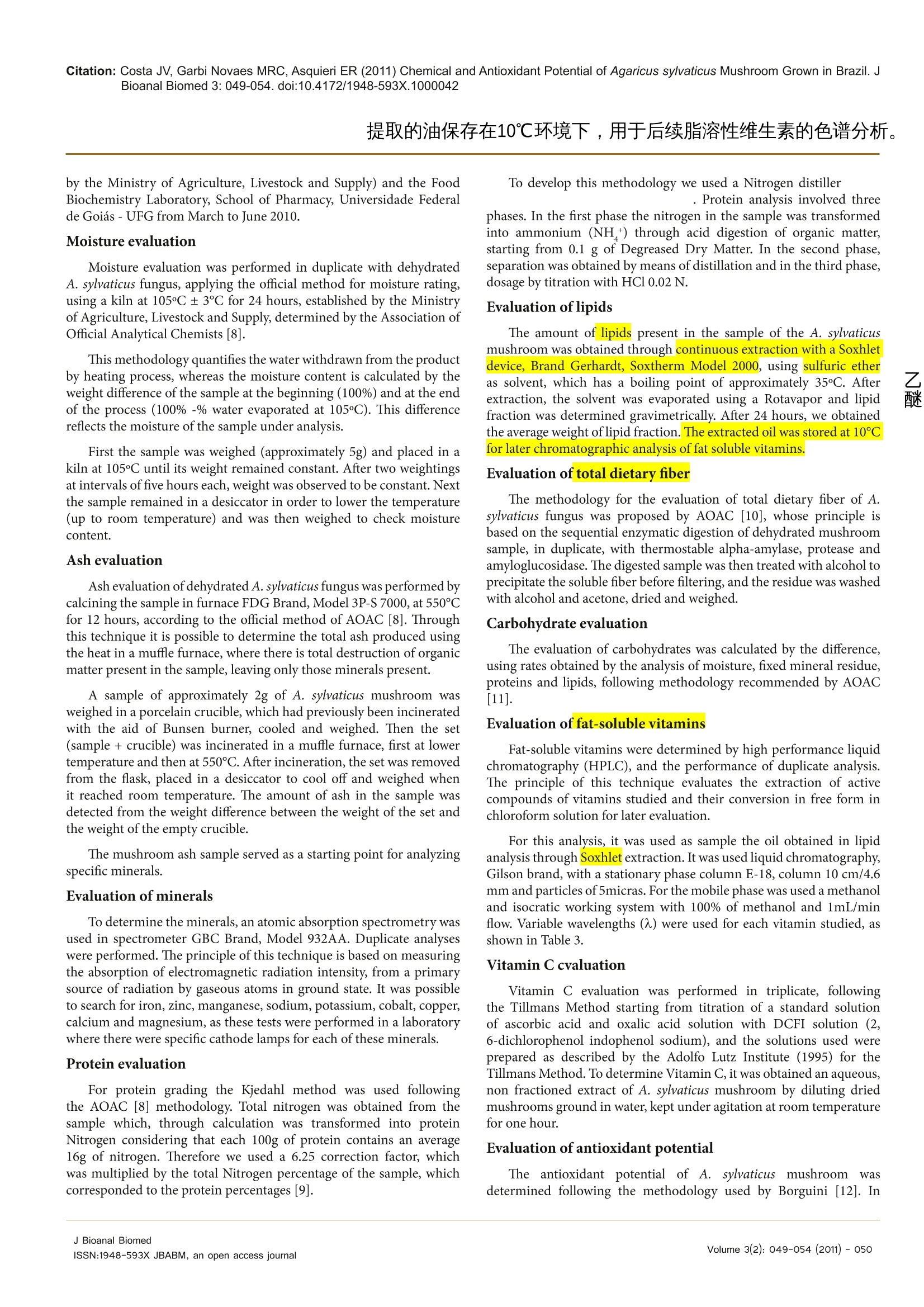
还剩4页未读,是否继续阅读?
继续免费阅读全文产品配置单
中国格哈特为您提供《姬松茸(太阳菇)中蛋白质、脂肪、膳食纤维含量检测以及脂溶性维生素分析的样品提取前处理》,该方案主要用于食用菌制品中营养成分检测,参考标准《暂无》,《姬松茸(太阳菇)中蛋白质、脂肪、膳食纤维含量检测以及脂溶性维生素分析的样品提取前处理》用到的仪器有格哈特全自动快速索氏提取SOXTHERM、格哈特自动升降凯氏定氮电热消解仪KT-L 20s、格哈特带自动进样器凯氏定氮仪VAP500C、格哈特全自动型纤维分析仪FT12、格哈特维克松废气实验室废物处理系统涤气VS、德国移液器MM、凯氏定氮催化剂5.0g K2SO4+0.5g CuSO4 x 5H2O。
我要纠错
相关方案


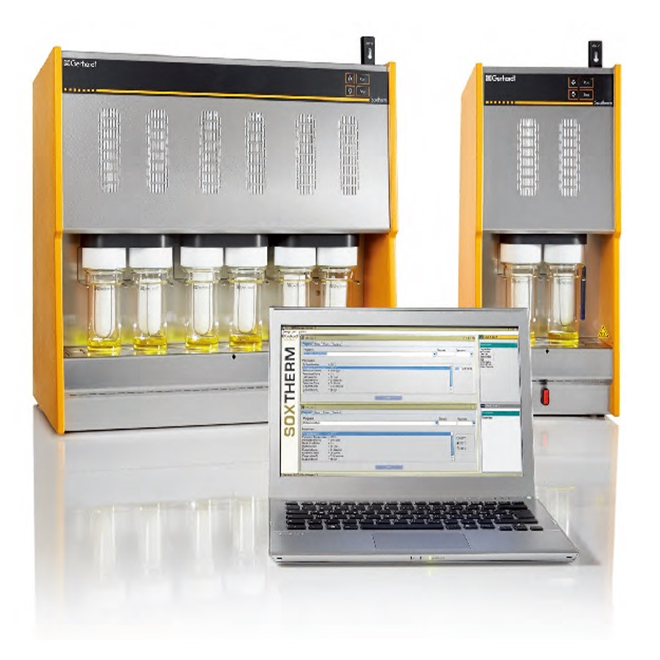
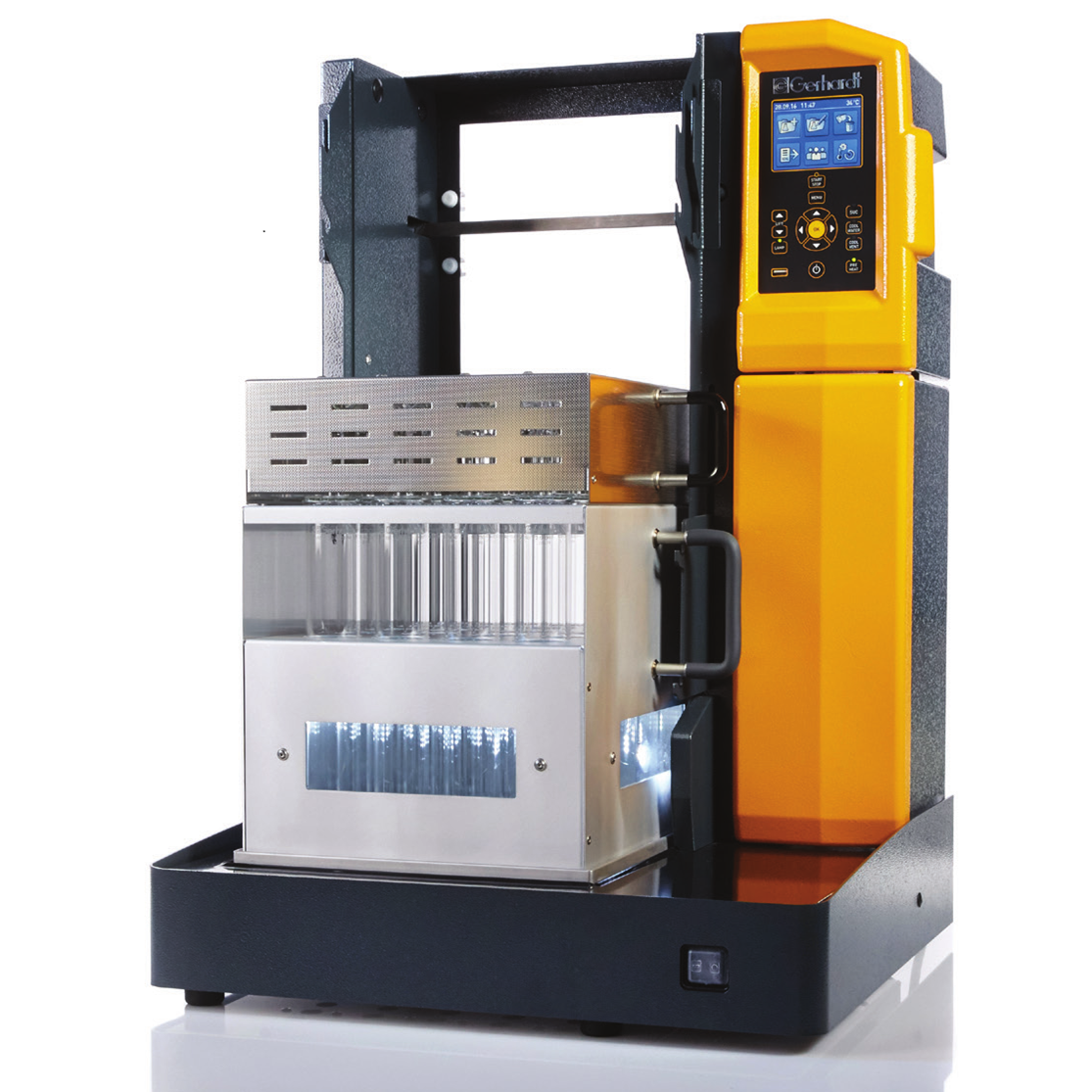
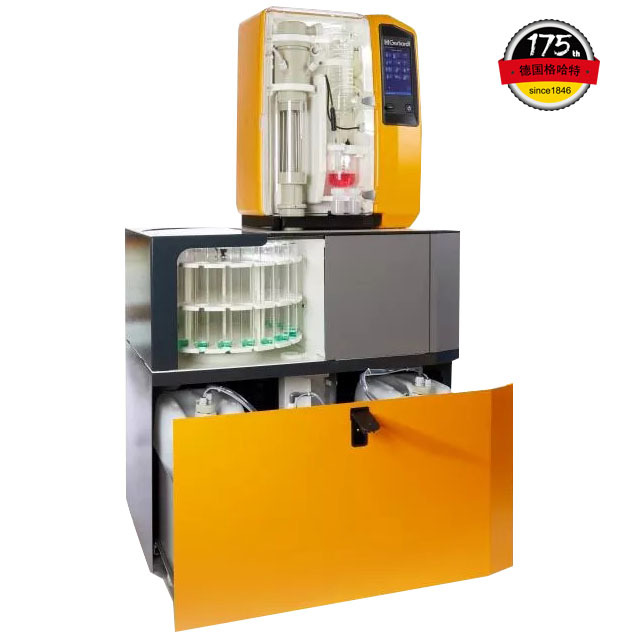

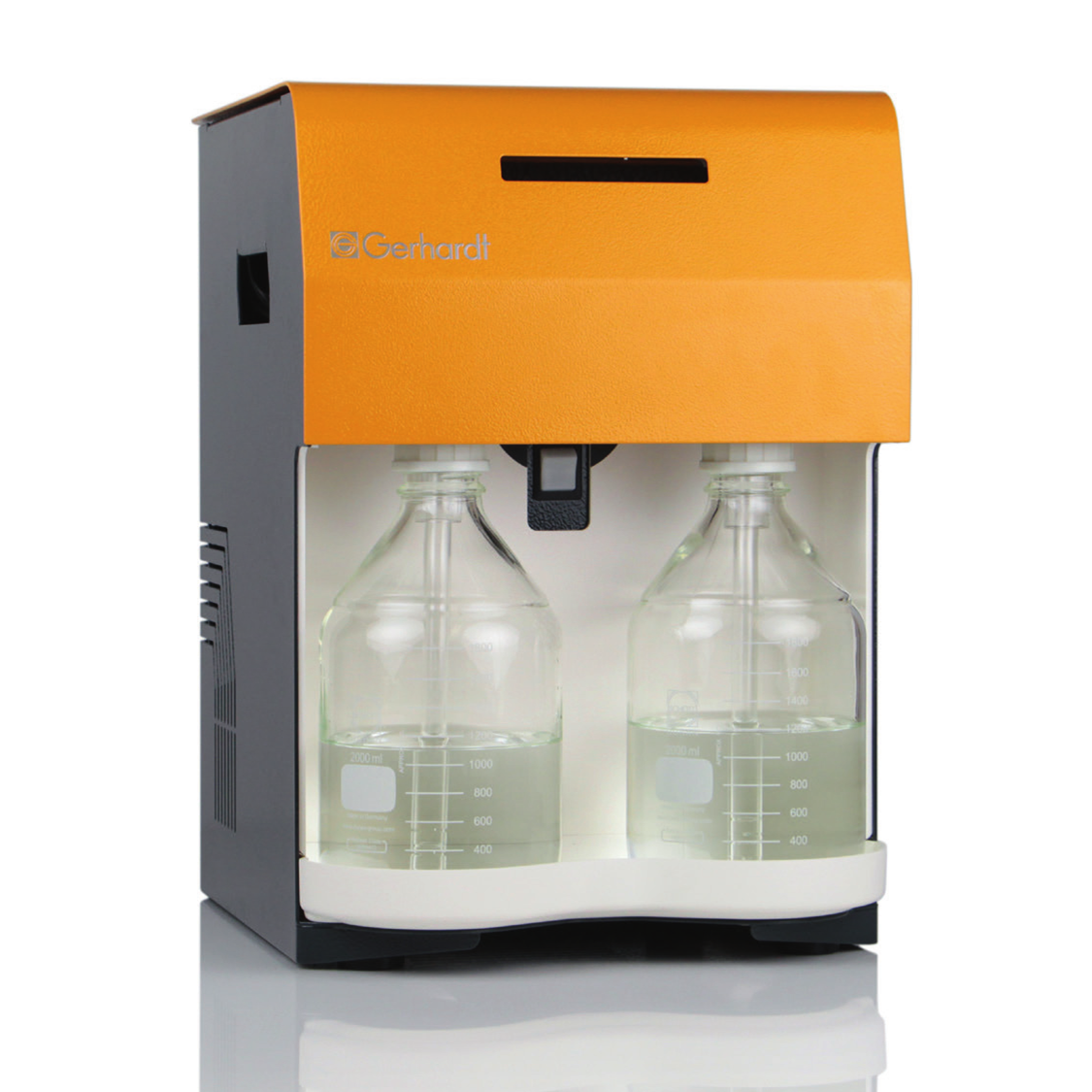
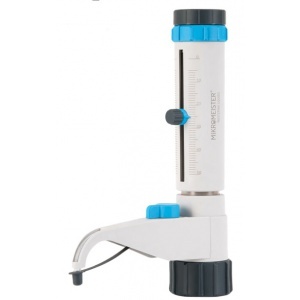
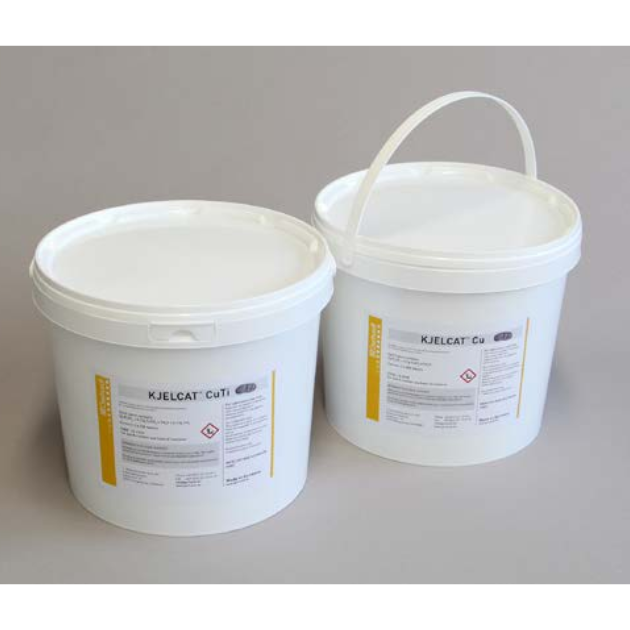

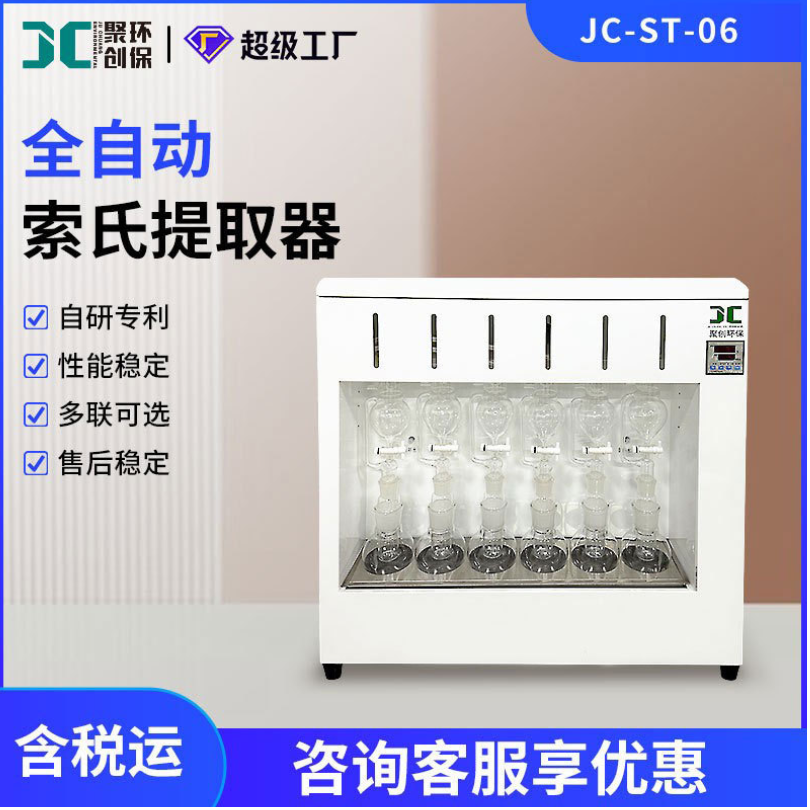

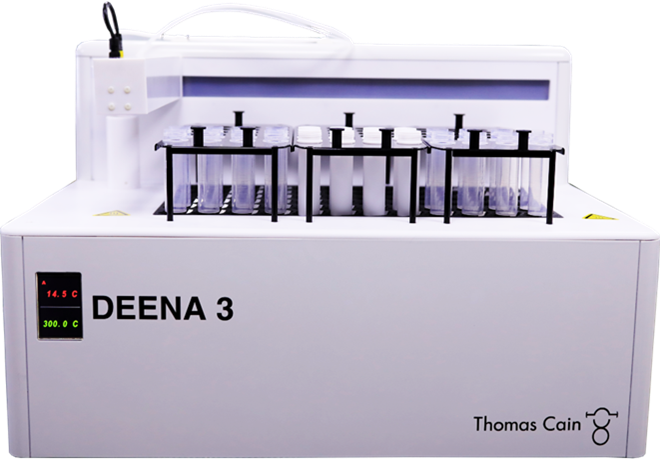

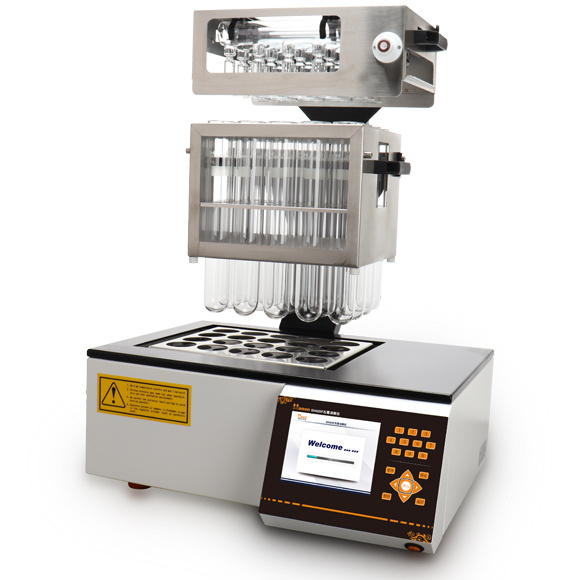

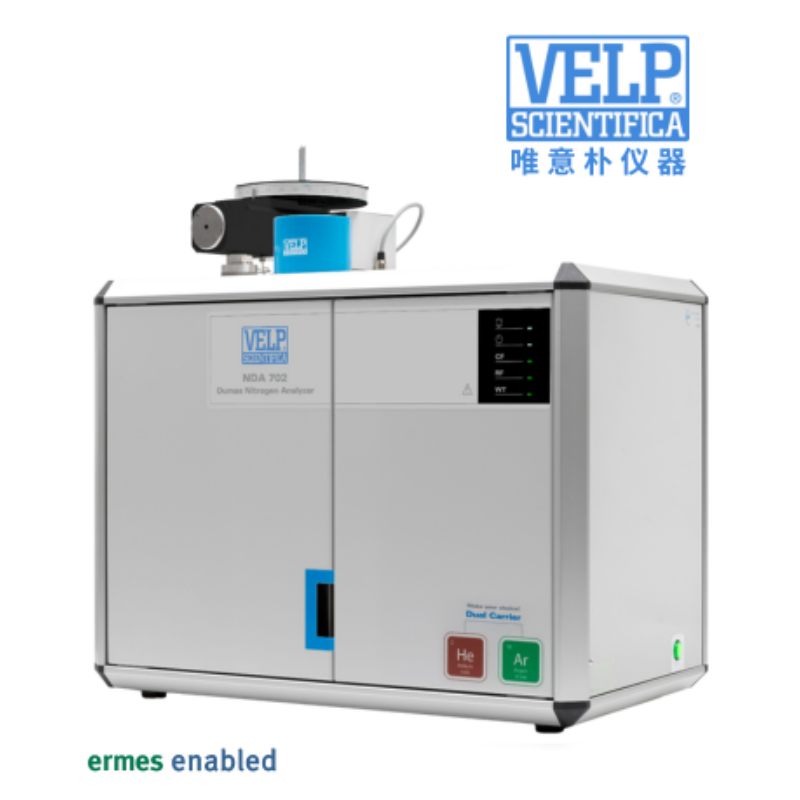

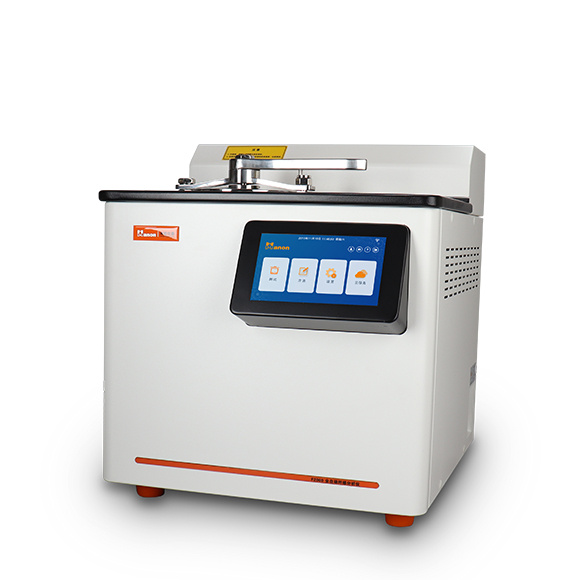

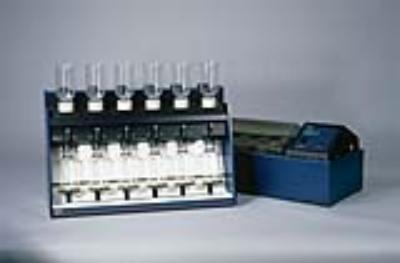
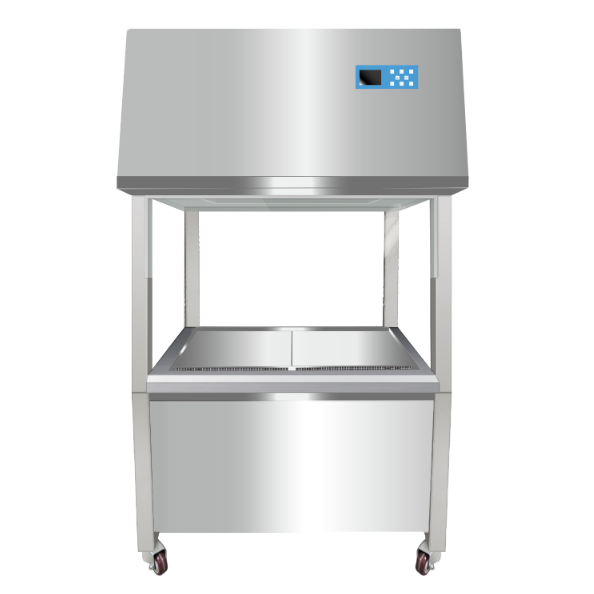

 咨询
咨询